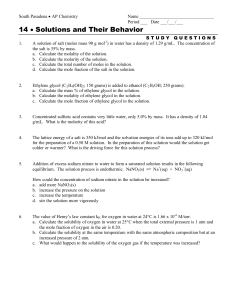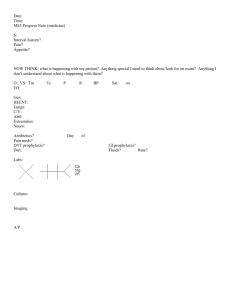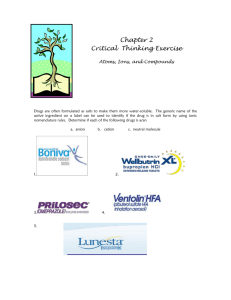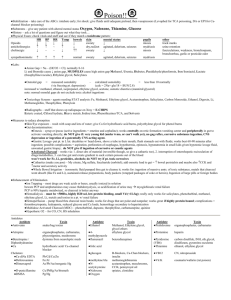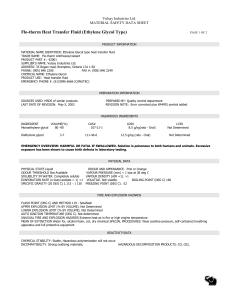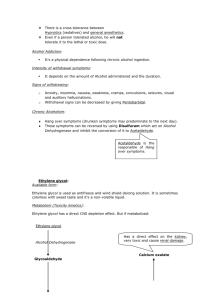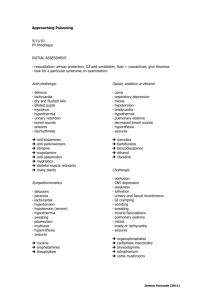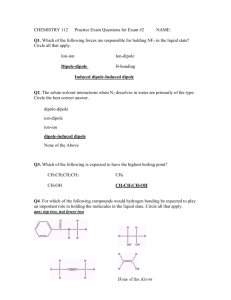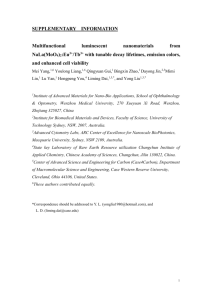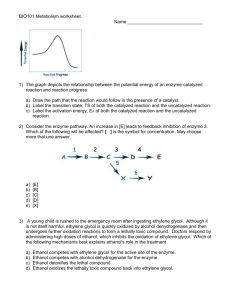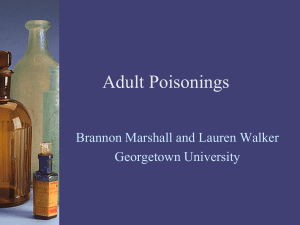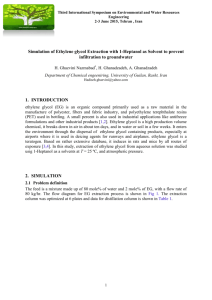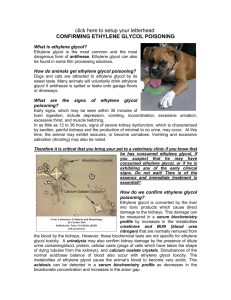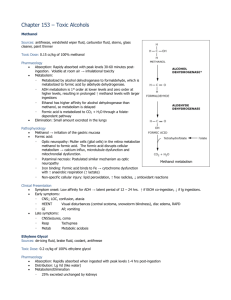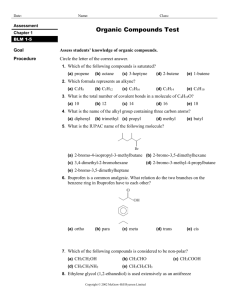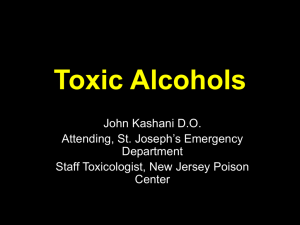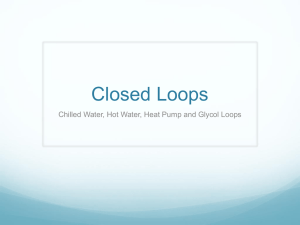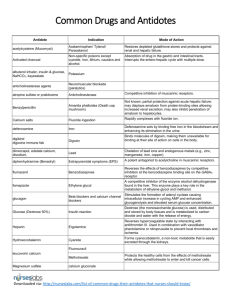Lecture No. 5
advertisement
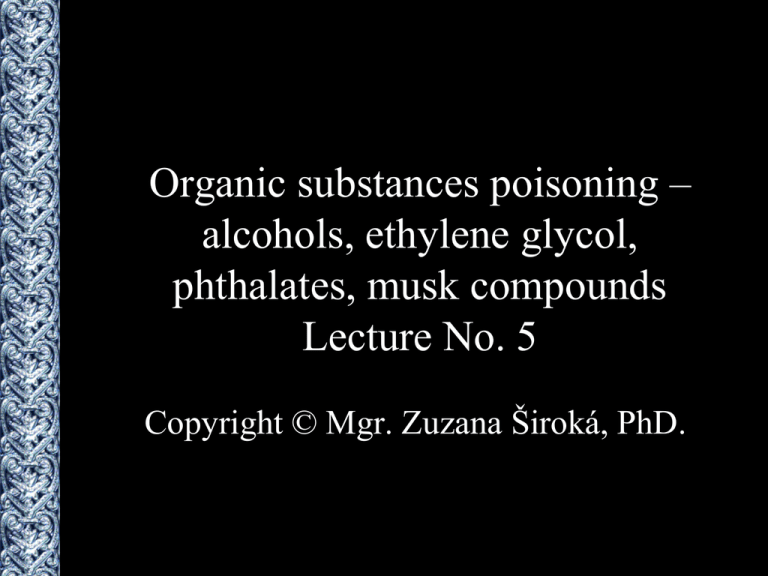
Organic substances poisoning – alcohols, ethylene glycol, phthalates, musk compounds Lecture No. 5 Copyright © Mgr. Zuzana Široká, PhD. Alcohols Ethanol - Poisoning by pure alcohol not very common in animals - Possible ingestion of fermented fruits or of dough containing yeasts, less from cosmetic products - Rapidly absorbed, interaction with many neurotransmiters and other systems (influences GABA and NMDA receptors, dissolves lipids in membranes) - First excitation, then depression of CNS, causes hypoglycaemia, disturbs thermoregulation, blocks production of adiuretin - Its metabolite acetaldehyde is also toxic (alcohol dehydrogenase) - In 1 ‰ – excitation of CNS, muscle incoordination, diuresis = dehydration, thirst (due to the lack of antidiuretic hormone - hangover) In 2 ‰ – strong inebriety, inability to move exactly In 3-4 ‰ – coma, decrease of temperature (vasodilatation of skin capillaries), blood pressure, respiration, metab. acidosis - Chronic intake: gastritis (increased secretion of digestive juices, vasoconstriction in GIT), stomach ulcers, steatosis and cirrhosis of liver, polyneuritis, worse immune reactions, deficit of thiamine (feeding with waste from brewery etc.) - Treatment: symptomatic - liquids, glucose, correction of acid-base balance, monitoring of heart function and respiration. In chronic poisoning supplementation of thiamine. Activated charcoal is not effective. It is possible to perform haemodialysis. Methanol - Colourless liquid - Used as a solvent, antifreeze, fuel, released from sweetening agent called aspartam - Absorbed after ingestion, inhalation, via skin - In an organism converted to formaldehyde and formic acid – by alcohol dehydrogenase, much faster then ethanol. These products toxic (bind to Fe3+ in breathing enzymes), not methanol! - Formic acid degraded to CO2 and H2O, but folic acid is necessary for this process – after a short time – depletion of folic acid - Low activity of enzymes necessary for the conversion to CO2 in humans (poisonings on the CR, Poland, India), apes, pigs (LD 1,5 ml/kg). Other species less sensitive (e.g. Dog 5-11 ml/kg). - In sensitive species very slowly excreted – acummulation - First nausea, vomiting, headache, dizziness, other symptoms after a several hours’ latency - Atrophy of optic nerve – blindness, decreased heart function, incoordination, cyanosis, seizures, death - Emetics, ethanol!!! – is first metabolised and methanol can be excreted unchanged (especially by lungs), bicarbonates to control acidosis, haemodialysis. Activated charcoal ineffective Ethylene glycol – winter poisoning - Colourless, odourless, syrupy liquid with a sweet taste - Coolant or antifreeze in automobiles and personal computers, important in the plastics industry for the manufacture of polyester fibers and resins, in cosmetics and cleaning products etc. - Rapid absorption (even after inhalation, quick metabolism, acute poisonings - In an organism converted to oxalic acid, which is nephrotoxic - LD dog 4,4 ml/kg, cat 0,9 ml/kg - Symptoms of ethylene glycol poisoning usually follow a three-step progression Stage 1: neurological symptoms, dizziness, headaches, confusion. Over time, the body metabolizes ethylene glycol into other toxins first it is metabolized to glycolaldehyde, which is then oxidized to glycolic acid, glyoxylic acid, and finally oxalic acid Stage 2: is a result of accumulation of these metabolites - tachycardia, hypertension, hyperventilation and metabolic acidosis Stage 3: kidney injury leading to acute kidney failure - oxalic acid reacts with calcium and forms calcium oxalate crystals in the kidney – usually death, oxalates in kidney is typical pathological sign. Uremia, vomiting, oral ulceration, seizures, death. • - The antidotes for ethylene glycol poisoning are ethanol or fomepizole, efficient in first 4 hours, later not. ethanol (usually given i.v. as a 5 or 10% solution in 5% dextrose) - competition with ethylene glycol for the enzyme alcohol dehydrogenase - decreases the formation of toxic metabolites fomepizole (4-methylpyrazole) – inhibition of alcohol dehydrogenase – blockage of the formation of the toxic metabolites - Haemodialysis can also be used to enhance the removal of unmetabolized ethylene glycol, as well as its metabolites from the body Propylene glycol - Replaces ethylene glycol - Antifreeze, solvent, in cosmetics, pharmaceuticals, food additive - A bit less toxic than ethylene glycol (LD for dog 9 ml/kg) - After ingestion changed to lactate, makes acidosis. In horses and cats moreover causes damage to erythrocytes and formation of Heinz bodies (anaemia). - Depression, ataxia, tremors, circulatory collapse Phthalates • Salts of phthalic acid • Used as plasticizers in polyvinyl chloride industry in toys, nail polish, fishing lures, adhesives, caulk, paint pigments • Easily released from plastic toys or from containers to food (mainly in higher temperature), no covalent bond with plastic, some of them volatile • Have xenoestrogenic (antiandrogenic) and • carcinogenic effect (only animals), • lipophilic, found mainly in soil or water and sediments food chain • Absorbed orally and via skin • Degradation in an organism – no oxidation/reduction, only conjugation • 80 % excreted in urine and bile, rest accumulated in fatty tissue • Acute toxicity: tiredness, blurred vision, lacrimation Chronic toxicity: damage of liver, kidneys, increased pigmentation, disturbances of reproduction, risk of allergies in children, increased risk of diabetes development Bisphenol A (BPA) - Plasticizer – no colour, to make bottles, CDs and DVDs, coating in waterpipes, cans etc. - Now banned in baby products - Endocrine disruptor: - binds to estrogen receptor - problem with brain development in fetuses - increased risk of obesity - disruption of thyroid function - possible carcinogen Musk compounds • Nitro and polycyclic musks – frequently used as fragrance ingredients in personal care products • Found in humans and aquatic organisms • Inhibit the activity of multidrug efflux transporters responsible for multixenobiotic resistance (MXR) xenobiotics are able to enter the cell (transporter proteins responsible for MXR include P-glycoprotein, multidrug-resistance protein and other members of the ATP-binding cassette family of transport proteins ) • Low binding affinity to estrogen receptors – also weak xenoestrogens • More info: http://en.wikipedia.org/wiki/Effects_of_alcohol_ on_the_body • http://www.methanol.org/ • http://www.methanol.com.au/_aboutmethanol.asp • http://www.jtbaker.com/msds/englishhtml/E5125 .htm • http://www.epa.gov/ttn/atw/hlthef/ethy-gly.html • http://www.phthalates.com/ • http://www.phthalates.org/index.asp • http://findarticles.com/p/articles/mi_m0CYP/is_1 _113/ai_n15625807
